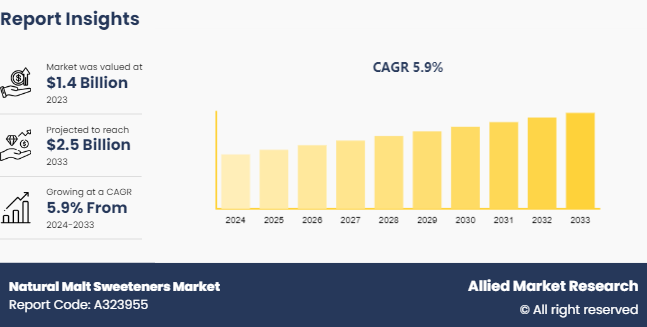Natural Malt Sweeteners Market Research, 2033
Market Introduction and Definition
The global natural malt sweeteners market was valued at $1.4 billion in 2023, and is projected to reach $2.5 billion by 2033, growing at a CAGR of 5.9% from 2024 to 2033. Natural malt sweeteners are a sweetening substance that comes from malted grains, usually barley, via a process referred to as malting. During this process, enzymes transform grain polysaccharides into sugars, predominantly maltose, producing a naturally available sweetener with a moderate, caramel-like flavor. Natural malt sweeteners, unlike processed sugars, are generally prized for their reduced glycemic index and trace nutritional content, which makes them an attractive option among health-conscious customers and producers looking to make cleaner-label goods. The market for natural malt sweeteners is being driven largely by increased demand from consumers for natural and less processed ingredients, the expanding trend of well-being and health, and growing knowledge of the negative effects of sugar that is refined on health. Furthermore, the growth of the food and beverage sector, notably in the organic and natural product categories, as well as a demand for non-GMO and allergen-free components, are boosting the market. The adaptability of natural malt sweeteners in a variety of applications, including bakery, candy, and beverages, together with the growing preference for plant-based diets, all contribute considerably to market growth.

Key Takeaways
The natural malt sweeteners market study covers 20 countries. The research includes a segment analysis of each country in terms of value ($Billion) for the projected period 2024-2033.
More than 1, 500 product literatures, industry releases, annual reports, and other such documents of major natural malt sweeteners industry participants along with authentic industry journals, trade associations' releases, and government websites have been reviewed for generating high-value industry insights.
The study integrated high-quality data, professional opinions and analysis, and critical independent perspectives. The research approach is intended to provide a balanced view of global markets and to assist stakeholders in making educated decisions in order to achieve their most ambitious growth objectives.
Key market dynamics
Consumers' growing knowledge of the harmful health effects of synthetic and overly processed sweeteners has resulted in a growing need for natural alternatives such as malt sweeteners. Consumers are increasingly looking for clean-label items that do not include artificial substances, additives, or preservatives. This trend towards openness and purity in food ingredients is an important contributor to the natural malt sweeteners market growth, with manufacturers responding by reformulating goods to fit customer preferences.
One of the main constraints in the natural malt sweeteners market forecast period is the high production costs connected with malting procedures, as well as the scarcity of high-quality malted grains. Natural malt sweeteners require more labor and time to produce than conventional sweeteners, which might result in higher pricing. This price discrepancy may dissuade cost-conscious customers and producers, restricting the widespread use of natural malt sweeteners.
Continuous innovation in the manufacturing and distribution of natural malt sweeteners provides an important opportunity for market expansion. Advances in production technology that can cut costs while improving the quality and uniformity of natural malt sweeteners may assist them in competing in the market. Furthermore, imaginative marketing methods emphasizing the health advantages, natural sources, and distinct flavor profiles of malt sweeteners might reach a larger audience. Collaborations with food and beverage firms to create new products or reformulate current ones utilizing natural malt sweeteners are also a possible path for market growth.
Value Chain Analysis of Global Natural Malt Sweeteners Market
Raw Material Sourcing
The value chain for natural malt sweeteners starts with the procurement of high-quality raw materials, typically cereal grains such as barley, wheat, and corn. These grains are chosen based on their appropriateness for malting, involving certain characteristics like as high starch concentration and low moisture content.
Malting Process
The malting process is the foundation of natural malt sweeteners manufacturing. This entails soaking the grains in water to start germination, followed by drying in an environment that is monitored to stop germination at the ideal stage. During this process, enzymes in the grain convert starches into fermentable sugars, chiefly maltose, which serves as the natural malt sweetness.
Extraction and Filtration
After malting is completed, the sweet malt extract is made by crushing the grains that were malted and combining them with water?to extract sugars. This liquid extract is subsequently filtered to eliminate any solid residues, resulting in a pure and concentrated malt sweetener.
Packaging and Distribution
The final product, either liquid or powdered, is packed in accordance with industry standards to ensure compliance with regulatory safety and labeling requirements. The packaging is intended to safeguard the sweetener from humidity, light, and contamination during its transportation and storage.
Marketing and Sales
The final step in the value chain is marketing and sales, where manufacturers and distributors promote natural malt sweeteners to both B2B (business-to-business) and B2C (business-to-consumer) markets.

Market Segmentation
The natural malt sweeteners market is segmented into form, application, and region. On the basis of form, the market is divided into liquid and powder. As per application, the market is segregated into food processing and beverage processing. Region wise, the market is analyzed across North America, Europe, Asia-Pacific, and LAMEA.
Regional/Country Market Outlook
In Asia-Pacific, increased consumer awareness of well-being and health, along with rising disposable incomes, is driving demand for natural and organic food goods, such as malt sweeteners. This area also has significant development potential due to a developing middle class and the growing impact of Western eating patterns, which are encouraging the acceptance of more nutritious alternatives to refined sugars.
In North America, the market is being driven by the clean-label movement and an overwhelming need for non-GMO, natural ingredients, particularly in the organic and specialty food categories. The region's established food and beverage sector, together with continual innovation in product compositions, presents significant growth potential for natural malt sweeteners.
In Europe, strict food additive restrictions and an increasing consumer push for sustainable and ethically produced ingredients are major market growth factors. The European market additionally benefits from the growing demand for gluten-free and low-GI (glycemic index) goods, which frequently use natural malt sweeteners. Market dynamics in these locations are affected by competition from alternative natural sweeteners, regulatory hurdles, and high manufacturing costs for malt sweeteners.
Industry Trends:
There has been a growing consumer shift towards natural sweeteners, driven by the demand for clean-label products and concerns over artificial sweeteners. The U.S. Food and Drug Administration (FDA) has noted a rise in the use of natural sweeteners like malt in the food and beverage industry.
Natural malt sweeteners are increasingly being adopted in the beverage industry, particularly in non-alcoholic beverages like malt-based drinks, health drinks, and energy drinks. Coca-Cola, for instance, has introduced natural malt sweeteners in its product line in response to consumer demand for healthier options.
Regulatory bodies in various regions are endorsing natural sweeteners, including malt, due to their health benefits, which in turn is boosting market adoption. The European Food Safety Authority (EFSA) approved health claims related to the low glycemic index of natural malt sweeteners in 2022, which has led to a 20% increase in the use of malt sweeteners in European food products.
Competitive Landscape
The major players operating in the market competing for natural malt sweeteners market share include Bairds Malt Lt, Simpsons Malt Ltd., Muntons Malt plc, Malteurop Group, Crisp Malting Group Ltd, GrainCorp, Holland Malt, BOORTMALT, Viking Malt, and Briess Malt & Ingredients
Other players in market contributing to the natural malt sweeteners market size includes Cargill Incorporated, Ireks GmbH, Dohler GmbH, The Soufflet Group, Barmalt India Pvt. Ltd., Vivescia Industries SCA, Polttimo Oy, Malt Products Corporation,, and others.
Recent Key Strategies and Developments
In June 2023, Simpsons Malt Limited partnered with Yara and Varda to support sustainable malt production techniques. This approach can assist in mitigating the environmental effect of malt production.
In March 2021, Simpsons Malt confirmed its purchase of W.N. Lindsay Ltd to enhance its market share. W.N. Lindsay Ltd is a prominent supplier of malt components in Scotland, and the purchase of it by Simpsons Malt Limited will increase Simpsons' market position in Scotland.
In February 2020, Leopold Bros, a firm located in the US, teamed with BSG to sell a range of handcrafted malt products in small batches to enter the lucrative hand-made beer and craft brewing markets.
Key Benefits For Stakeholders
- This report provides a quantitative analysis of the market segments, current trends, estimations, and dynamics of the natural malt sweeteners market analysis from 2024 to 2033 to identify the prevailing natural malt sweeteners market opportunities.
- The market research is offered along with information related to key drivers, restraints, and opportunities.
- Porter's five forces analysis highlights the potency of buyers and suppliers to enable stakeholders make profit-oriented business decisions and strengthen their supplier-buyer network.
- In-depth analysis of the natural malt sweeteners market segmentation assists to determine the prevailing market opportunities.
- Major countries in each region are mapped according to their revenue contribution to the global market.
- Market player positioning facilitates benchmarking and provides a clear understanding of the present position of the market players.
- The report includes the analysis of the regional as well as global natural malt sweeteners market trends, key players, market segments, application areas, and market growth strategies.
Natural Malt Sweeteners Market Report Highlights
| Aspects | Details |
| Market Size By 2033 | USD 2.5 Billion |
| Growth Rate | CAGR of 5.9% |
| Forecast period | 2024 - 2033 |
| Report Pages | 230 |
| By Form |
|
| By Application |
|
| By Region |
|
| Key Market Players | BOORTMALT, Briess Malt & Ingredients, Holland Malt, Malteurop Group, GrainCorp, Bairds Malt Ltd, Simpsons Malt Ltd., Viking Malt, Crisp Malting Group Ltd, Muntons Malt plc |
The global natural malt sweeteners market was valued at $1.4 billion in 2023, and is projected to reach $2.5 billion by 2033, growing at a CAGR of 5.9% from 2024 to 2033.
The natural malt sweeteners market registered a CAGR of 5.9% from 2024 to 2033.
The forecast period in the natural malt sweeteners market report is from 2024 to 2033.
The top companies that hold the market share in the natural malt sweeteners market include Bairds Malt Lt, Simpsons Malt Ltd., Muntons Malt plc, Malteurop Group, Crisp Malting Group Ltd, and others.
The natural malt sweeteners market report has 2 segments. The segments are form and application.
Loading Table Of Content...



